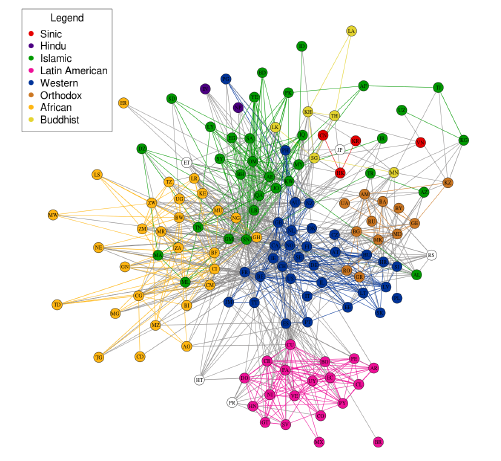Global E-mail Patterns Reveal “Clash of Civilizations”
Most political scientists consider the Cold War as a conflict between capitalist countries in the west and the Communist Bloc in the East. As such, it was essentially a conflict of ideology.

At the end of the Cold War, the question arose of what would drive the next wave of conflicts.
In 1992, the Harvard-based political scientist Samuel Huntington suggested that future conflicts would be driven largely by cultural differences. He went on to map out a new world order in which the people of the world are divided into nine culturally distinct civilisations.
These include: Western civilisation; Latin American civilisation; the Orthodox world of former Soviet Union countries; the Sinic civilisation including China, the Koreas and Vietnam; the Muslim world of the greater Middle East; Sub-Saharan Africa and so on.
His argument was that future conflicts would be based around the fault lines at the edges of these civilisations. He published this view in a now famous article called “The Clash of Civilizations?” in the politcal journal Foreign Affairs.
Certain events have since been used to support Huntington’s thesis–the War on Terror, for instance.
But an interesting question is whether there is evidence at the social scale of a “Clash of Civilisations”.
Today, we get an answer of sorts thanks to the work of Bogdan State at Stanford University in California and a few pals. These guys have analysed a global database of e-mail messages, and their locations, sent by more than 10 million people over the space of a year. State and co say that the pattern of connections between these people, clearly reflects the civilisations mapped out by Huntington. In other words, the way we send e-mails is a reflection of the mesh of civilisations that is an important driver of future conflict.
This was by no means an easy study to carry out. The messages were gathered by the internet company Yahoo!–all users had agreed to their data being used for research purposes. The data included each user’s profile giving their self-entered location and the geo-location of the IP address (only users with matching self-reported and IP locations were used).
The researchers then counted the instances in which users swapped messages with each other, considering this to be evidence of a tie between the countries where these users were located. This gave them a simple count of the number of ties between pairs of countries around the world.
But that was just the start. The hard work was in cleaning up the data since this simple count of ties is hugely distorted by the uneven data coverage caused by factors such as the different market share that Yahoo! enjoys in various parts of the world. So State and co undertook a comprehensive “rescaling” of the data to account for these effects.
The result is the network which appears above, which is colour coded according to the civilisations identified by Huntington. State and co say the groupings can be clearly seen by visual inspection. Indeed, they crunched the data using a number of community detection algorithms which all found a similar kind of grouping.
“This result provides evidence towards a division of the world into civilizational blocks following Huntington’s theory,” say State and pals.
But there are other patterns too. “The findings (unsurprisingly) support the idea that geography, transporation and administrative decisions are all important determinant of between-country communication: distance decreases density, as do visas, while direct flights increase it,” say the researchers.
And there are surprising results as well. For example, a common border between two countries actually reduces the communication density between them, perhaps because of increased tensions. “These curious findings do raise the issue of potential problems with European integration, as well as of the higher potential for conflict between countries sharing borders, which may lead to less communication,” say State and pals.
There are one or two caveats with this kind of research, the main one being that the process of rescaling the data can introduce artefacts that then influence the observed effects. However, further research with other data sets should help to iron out these problems.
Of course, if our planet is divided by civilisation in the way Huntington suggested, it’s not surprising that this is reflected in the pattern of global communication.
A more interesting question is whether this kind of computational social science can measure the ongoing pulse of global tensions and whether it has any predictive power over in spotting where the next conflicts are likely to arise.
That’s beyond the current state of the art but it’s clearly an area worth watching.
Ref: arxiv.org/abs/1303.0045: The Mesh of Civilizations and International E-mail Flows
Keep Reading
Most Popular
Large language models can do jaw-dropping things. But nobody knows exactly why.
And that's a problem. Figuring it out is one of the biggest scientific puzzles of our time and a crucial step towards controlling more powerful future models.
The problem with plug-in hybrids? Their drivers.
Plug-in hybrids are often sold as a transition to EVs, but new data from Europe shows we’re still underestimating the emissions they produce.
Google DeepMind’s new generative model makes Super Mario–like games from scratch
Genie learns how to control games by watching hours and hours of video. It could help train next-gen robots too.
How scientists traced a mysterious covid case back to six toilets
When wastewater surveillance turns into a hunt for a single infected individual, the ethics get tricky.
Stay connected
Get the latest updates from
MIT Technology Review
Discover special offers, top stories, upcoming events, and more.